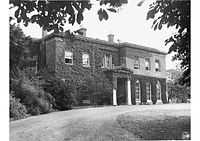Stanwell Place
| Stanwell Place | |
|---|---|
 | |
| General information | |
| Type | Rendered brick |
| Location | Stanwell, Middlesex, United Kingdom |
| Coordinates | 51°27′32″N 0°29′28″W / 51.459°N 0.4912°W |
| Completed | Early 19th Century |
| Demolished | 1960s |
| Technical details | |
| Other dimensions | Approximately 30 rooms |
Stanwell Place was a manor house and associated estate and tenant farms, located to the west of the village of Stanwell, Middlesex. Built from the 17th century, during the early part of the 20th century it was sold off to create a reservoir and series of local small holdings.
The manor house was constructed in the 17th century at least, laying about half a mile to the west of the village, north of Park Road.[1] The last house to stand on the site is believed to have been built in the early part of the 19th Century by the Gibbons family, who owned the manorial rights from 1754 to 1933. The house had two stories and was cement rendered with a low-pitched roof behind a parapet. The later west wing was built of red brick and part of the outbuildings were older than the main house.
The surrounding park land was laid out in the 18th century. The bend at the entrance gates in Park Road is probably due to Sir John Gibbons diverting the road in 1760. After Gibbons enclosed Borough Field in 1771 the Park extended from Oaks Road in the east to Borough Green to the north and was over 300 acres (1.2 km2). The size of the park reduced over the years however.[2][3]
The Gibbons family sold Stanwell Place to civil engineer Sir John Watson Gibson in 1933. Gibson moved to Stanwell whilst building the Queen Mary Reservoir at Littleton,(the largest water storage reservoir in the world at that time). Living at Stanwell Lodge before his purchase of Stanwell Place (90 acres), and the adjoining Stanhope farm (261 acres, including Hammonds farm).[4] In 1936 the Metropolitan Water Board bought most of Gibson's estate, in a contract encompassing 346 acres.[5] It used this land in 1947 on which to develop the King George VI Reservoir.[4]
During the World War II Gibson through his work as deputy director-general civil engineering (special) at the Ministry of Supply (1943–4) he was one of the principal people responsible for the construction of the top secret Mulberry Harbours. It was as a result of this that he lent Stanwell Place to the SHAEF Commanders where they held two top level meetings during the build up to D-Day and the Normandy Invasion. The American high command including Henry L. Stimson, General George C. Marshall, General Dwight D. Eisenhower, Admiral Ernest J. King and General of the Air Force Henry H. Arnold stayed at Stanwell Place during the meetings.[6]
After Gibson’s death, Stanwell Place and its residual 22acres were sold to King Faisal II of Iraq. Gibson's sons still owned the residual 17 acres of Stanhope farm.[5] After the assassination of King Faisal in 1958,[3] the estate was purchased for gravel extraction. Despite local attempts to prevent it, the house was allowed to become derelict and eventually knocked down.
References
- ↑ Google Inc. "Location of Stanwell Place". Google Maps (Map). Cartography by Google, Inc. http://maps.google.com/maps?q=51.459,-0.4912+(Location+of+Stanwell+Place)&t=h&z=17.
- ↑ 'Stanwell: Introduction', A History of the County of Middlesex: Volume 3: Shepperton, Staines, Stanwell, Sunbury, Teddington, Heston and Isleworth, Twickenham, Cowley, Cranford, West Drayton, Greenford, Hanwell, Harefield and Harlington (1962), pp. 33-36.
- ↑ 3.0 3.1 'Stanwell: Manors', A History of the County of Middlesex: Volume 3: Shepperton, Staines, Stanwell, Sunbury, Teddington, Heston and Isleworth, Twickenham, Cowley, Cranford, West Drayton, Greenford, Hanwell, Harefield and Harlington (1962), pp. 36-41
- ↑ 4.0 4.1 Local List - Statement of Public Consultation. Stanwell Borough Council. December 2003.
- ↑ 5.0 5.1 Susan Reynolds (1962). "A History of the County of Middlesex: Volume 3". british-history.ac.uk. Retrieved 2010-01-02.
- ↑ Spelthorne Borough Council - Local List of Buildings and Structures of Architectural or Historic Interest - February 2004: Burial Monument of Sir John Gibson
| |||||||||||||||||||||||||||||||||||||||||
